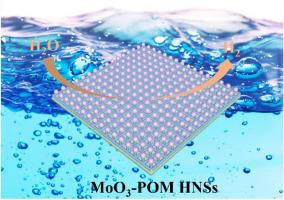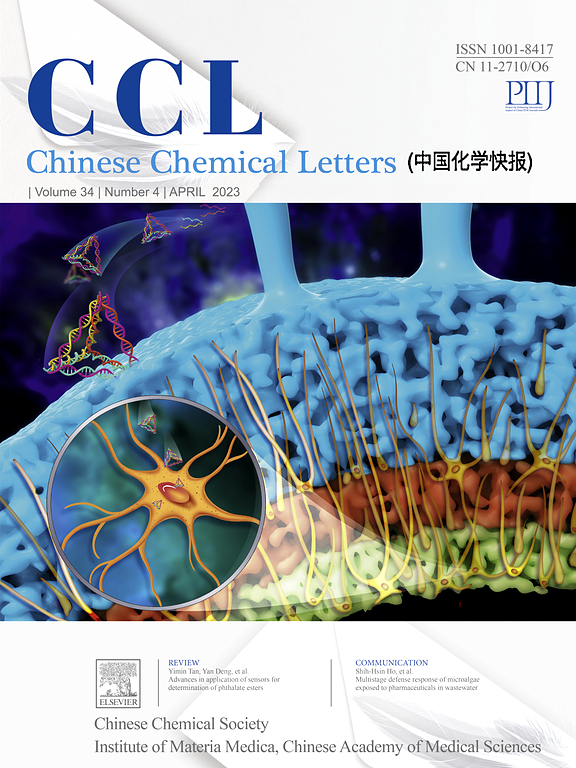Structuring MoO3-polyoxometalate hybrid superstructures to boost electrocatalytic hydrogen evolution reaction
IF 9.4
1区 化学
Q1 CHEMISTRY, MULTIDISCIPLINARY
引用次数: 0
Abstract
Improving the surface atoms utilization efficiency of catalysts is extremely important for large-scale H2 production by electrochemical water splitting, but it remains a great challenge. Herein, we reported two kinds of MoO3-polyoxometalate hybrid nanobelt superstructures (MoO3-POM HNSs, POM = PW12O40 and SiW12O40) using a simple hydrothermal method. Such superstructure with highly uniform nanoparticles as building blocks can expose more surface atoms and emanate increased specific surface area. The incorporated POMs generated abundant oxygen vacancies, improved the electronic mobility, and modulated the surface electronic structure of MoO3, allowing to optimize the H* adsorption/desorption and dehydrogenation kinetics of catalyst. Notably, the as-prepared MoO3-PW12O40 HNSs electrodes not only displayed the low overpotentials of 108 mV at 10 mA/cm2 current density in 0.5 mol/L H2SO4 electrolyte but also displayed excellent long-term stability. The hydrogen evolution reaction (HER) performance of MoO3-POM superstructures is significantly better than that of corresponding bulk materials MoO3@PW12O40 and MoO3@SiW12O40, and the overpotentials are about 8.3 and 4.9 times lower than that of single MoO3. This work opens an avenue for designing highly surface-exposed catalysts for electrocatalytic H2 production and other electrochemical applications.

构建 MoO3-聚氧化金属酸盐混合超结构,促进电催化氢气进化反应
提高催化剂的表面原子利用效率对于电化学水分离大规模生产 H2 极其重要,但这仍然是一个巨大的挑战。在此,我们采用简单的水热法报道了两种 MoO3 聚氧化铝杂化纳米带上层结构(MoO3-POM HNSs,POM = PW12O40 和 SiW12O40)。这种以高度均匀的纳米颗粒为构件的超结构可以暴露出更多的表面原子,并增加比表面积。加入的 POM 产生了大量的氧空位,提高了电子迁移率,并调节了 MoO3 的表面电子结构,从而优化了催化剂的 H* 吸附/解吸和脱氢动力学。值得注意的是,制备的 MoO3-PW12O40 HNSs 电极不仅在 0.5 mol/L H2SO4 电解液中以 10 mA/cm2 的电流密度显示出 108 mV 的低过电位,而且显示出优异的长期稳定性。MoO3-POM 超结构的氢进化反应(HER)性能明显优于相应的块体材料 MoO3@PW12O40 和 MoO3@SiW12O40,其过电位分别是单一 MoO3 的 8.3 倍和 4.9 倍。这项工作为设计用于电催化制取 H2 及其他电化学应用的高表面暴露催化剂开辟了一条途径。
本文章由计算机程序翻译,如有差异,请以英文原文为准。
求助全文
约1分钟内获得全文
求助全文
来源期刊

Chinese Chemical Letters
化学-化学综合
CiteScore
14.10
自引率
15.40%
发文量
8969
审稿时长
1.6 months
期刊介绍:
Chinese Chemical Letters (CCL) (ISSN 1001-8417) was founded in July 1990. The journal publishes preliminary accounts in the whole field of chemistry, including inorganic chemistry, organic chemistry, analytical chemistry, physical chemistry, polymer chemistry, applied chemistry, etc.Chinese Chemical Letters does not accept articles previously published or scheduled to be published. To verify originality, your article may be checked by the originality detection service CrossCheck.
 求助内容:
求助内容: 应助结果提醒方式:
应助结果提醒方式:


